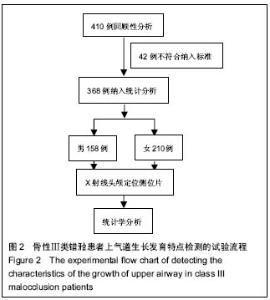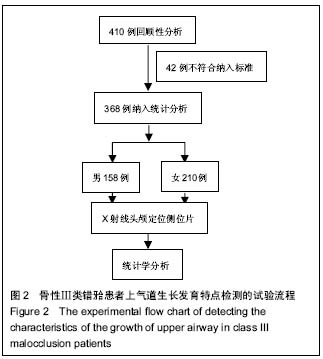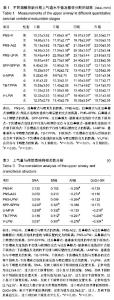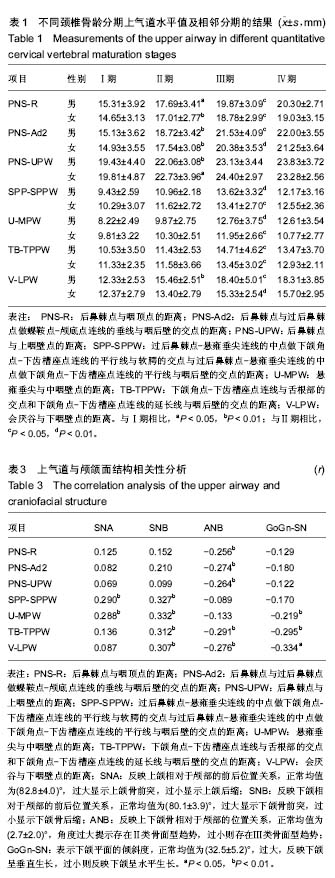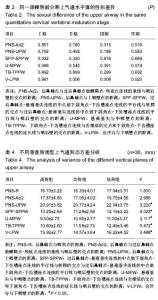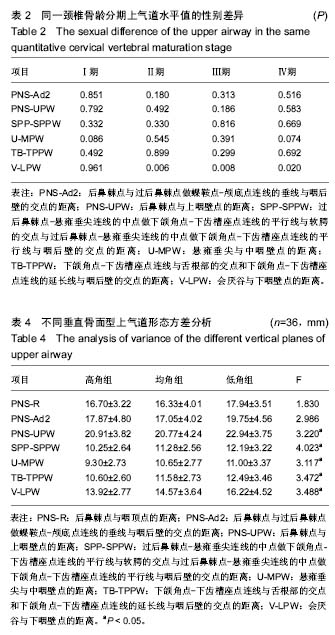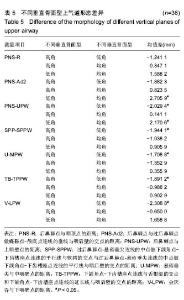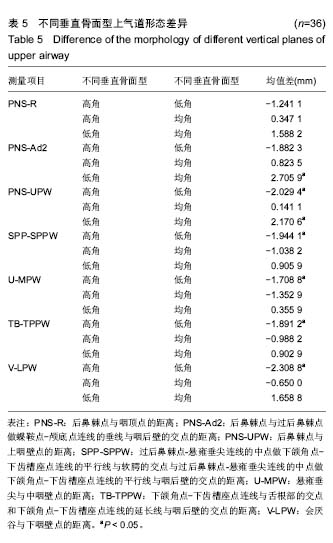| [1] Lopatiene K, Babarskas A. Malocclusion and upper airway obstruction. Medicina (Kaunas). 2002;38(3):277-283.[2] 王宏伟,王建国,齐素青,等.正畸-正颌联合治疗骨性Ⅲ类错(牙合)畸形对咽腔间隙影响的三维重建分析[J].中华口腔医学杂志, 2012,47(4):221-224.[3] 匡威.正畸正颌联合治疗骨性下颌前突畸形前后舌咽形态及功能变化的研究[D].西安:第四军医大学,2008. [4] Chen LL, Xu TM, Jiang JH, et al. Quantitative cervical vertebral maturation assessment in adolescents with normal occlusion: a mixed longitudinal study. Am J Orthod Dentofacial Orthop. 2008; 134(6):720.e1-720.e7; discussion 720-721. [5] Chen L, Liu J, Xu T, et al. Quantitative skeletal evaluation based on cervical vertebral maturation: a longitudinal study of adolescents with normal occlusion. Int J Oral Maxillofac Surg. 2010;39(7):653-659. [6] 唐志慧,曾祥龙.恒牙早期正常骨面型青少年上气道形态和舌骨位置的X线头影测量研究[J].北京大学学报(医学版), 2002, 34(2):140-143.[7] Samman N, Mohammadi H, Xia J. Cephalometric norms for the upper airway in a healthy Hong Kong Chinese population. Hong Kong Med J. 2003;9(1):25-30.[8] 郭涛,丁寅.正常骨面型儿童?成人上气道形态的X线头影测量分析[J].北京口腔医学,2006,14(4):247-250.[9] 罗家燕.骨龄评价与儿童生长发育[J] .国外医学:口腔医学分册, 1998,25(2):96.[10] Hassel B, Farman AG. Skeletal maturation evaluation using cervical vertebrae. Am J Orthod Dentofacial Orthop. 1995; 107(1):58-66.[11] Baccetti T, Reyes BC, McNamara JA Jr. Craniofacial changes in Class III malocclusion as related to skeletal and dental maturation. Am J Orthod Dentofacial Orthop. 2007;132(2): 171.e1-171.e12.[12] Reyes BC, Baccetti T, McNamara JA Jr. An estimate of craniofacial growth in Class III malocclusion. Angle Orthod. 2006;76(4):577-584.[13] 赵祝,李东,宋镜明,等.安氏Ⅲ类错(牙合)患者下颌骨生长发育特点[J].实用口腔医学杂志,2011,27(2):222-225.[14] Alves PV, Zhao L, O'Gara M, et al. Three-dimensional cephalometric study of upper airway space in skeletal class II and III healthy patients. J Craniofac Surg. 2008;19(6): 1497-1507.[15] Katayama K, Yamaguchi T, Sugiura M, et al. Evaluation of mandibular volume using cone-beam computed tomography and correlation with cephalometric values. Angle Orthod. 2014;84(2):337-342. [16] Claudino LV, Mattos CT, Ruellas AC, et al. Pharyngeal airway characterization in adolescents related to facial skeletal pattern: a preliminary study. Am J Orthod Dentofacial Orthop. 2013;143(6):799-809.[17] Kaur S, Rai S, Kaur M. Comparison of reliability of lateral cephalogram and computed tomography for assessment of airway space. Niger J Clin Pract. 2014;17(5):629-636. [18] Chang Y, Koenig LJ, Pruszynski JE, et al. Dimensional changes of upper airway after rapid maxillary expansion: a prospective cone-beam computed tomography study. Am J Orthod Dentofacial Orthop. 2013;143(4):462-470. [19] Jiang YY, Xu X, Su HL, et al. Gender-related difference in the upper airway dimensions and hyoid bone position in Chinese Han children and adolescents aged 6-18 years using cone beam computed tomography. Acta Odontol Scand. 2015; 73(5):391-400. [20] Iwasaki T, Hayasaki H, Takemoto Y, et al. Oropharyngeal airway in children with Class III malocclusion evaluated by cone-beam computed tomography. Am J Orthod Dentofacial Orthop. 2009;136(3):318.e1-9; discussion 318-319. [21] Zheng ZH, Yamaguchi T, Kurihara A, et al. Three-dimensional evaluation of upper airway in patients with different anteroposterior skeletal patterns. Orthod Craniofac Res. 2014; 17(1):38-48.[22] Hong JS, Oh KM, Kim BR, et al. Three-dimensional analysis of pharyngeal airway volume in adults with anterior position of the mandible. Am J Orthod Dentofacial Orthop. 2011;140(4): e161-169. [23] Di Carlo G, Polimeni A, Melsen B, et al. The relationship between upper airways and craniofacial morphology studied in 3D. A CBCT study. Orthod Craniofac Res. 2015;18(1):1-11. [24] Lee Y, Chun YS, Kang N, et al. Volumetric changes in the upper airway after bimaxillary surgery for skeletal class III malocclusions: a case series study using 3-dimensional cone-beam computed tomography. J Oral Maxillofac Surg. 2012;70(12):2867-2875. [25] Becht MP, Mah J, Martin C, et al. Evaluation of masseter muscle morphology in different types of malocclusions using cone beam computed tomography. Int Orthod. 2014;12(1): 32-48. [26] Moss ML, Salentijn L. The primary role of functional matrices in facial growth. Am J Orthod. 1969;55(6):566-577.[27] McNamara JA. Influence of respiratory pattern on craniofacial growth. Angle Orthod. 1981;51(4):269-300.[28] 徐宝华,高炜,林久祥.儿童鼻阻塞性口呼吸与颌面畸形[J].中国医刊,1992,27(9):38-39.[29] 高雪梅,杨凯,曾祥龙.儿童呼吸方式与颌面生长发育的关系[J].中华医学杂志,2005,85(44):3105-3106. [30] Kandasamy S, Goonewardene M. Class II malocclusion and sleep-disordered breathing. Semin Orthod. 2014; 20(4): 316-323. |
